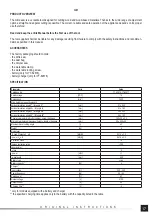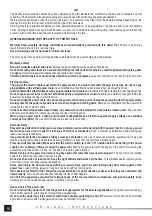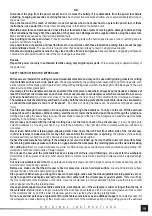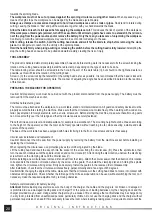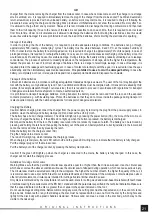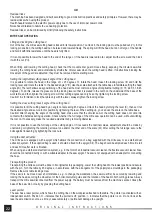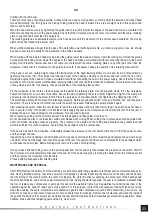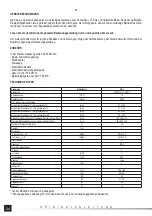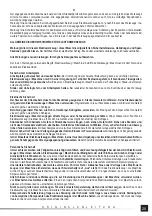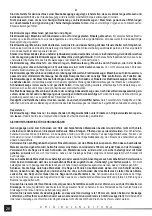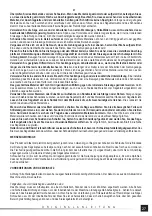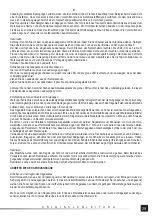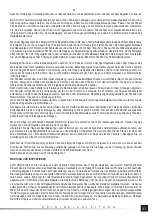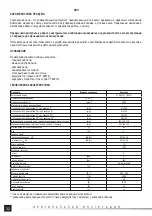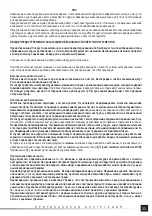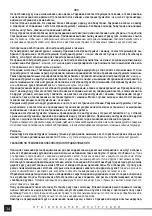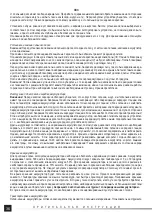
21
O R I G I N A L I N S T R U C T I O N S
GB
charger from the mains, removing the charger from the mains socket. In case when smoke comes out of the charger, or a strange
smell is emitted, etc., it is required to immediately remove the plug of the charger from the mains socket! The drill and automatic
return screwdriver is provided with an unloaded battery, so before work may commence, it is required to charge it following the
procedure below, using the charger and charging dock provided. Li-ION batteries do not show the so called “memory eff ect”, so
it is allowed to charge them at any moment. However, it is recommended to discharge them during normal work, and then load
them to their full capacity. If due to the nature of the task it is not possible to do so each time, then it is required to do it at least
from time to time. Under no circumstances is it allowed to discharge the batteries short-circuiting the electrodes, since this would
cause irreversible damage! It is also prohibited to check the load of the batteries, short-circuiting the electrodes for sparking.
Storage of the battery
In order to prolong the life of the battery, it is required to provide adequate storage conditions. The batteries can go through
approximately 500 „loading - discharging” cycles. The battery must be stored between 0 and 30°C, at the relative humidity of
50%. In order to store the battery for a prolonged period, it is required to charge it to approximately 70% of its capacity. In case of
prolonged storage, it is required to recharge the battery once a year. Do not permit excessive discharging of the battery, since this
would reduce its life and may cause irreversible damage. During storage, the battery will be gradually unloading due to leakage
conductance. The process of automatic unloading depends on the temperature of storage, since the higher the temperature, the
fastest the process. In case of incorrect storage of batteries, there is a danger of electrolyte leakage. In case of leakage, it is
required protect the leakage with neutralizing agent. In case of contact of electrolyte with the eyes, it is required to rinse the eyes
abundantly, and then immediately seek medical assistance.
It is prohibited to use a tool with a damaged battery.
In case the
battery is completely worn out, it is required to deposit it at a special point dedicated to disposal of such waste.
Transport of the batteries
Lithium-ion batteries are in accordance with legal regulations treated as dangerous waste. The user of the tool may transport the
tool with the battery or only batteries by land. Then no additional conditions must be complied with. In transport is realised by third
parties (for example dispatch through courier service), then it is required to proceed in accordance with regulations for transport
of dangerous materials. Before shipment, contact an authorised person.
It is prohibited to transport damaged batteries. During transport the battery must be removed from the tool, and the exposed
contacts protected, e.g. with insulating tape. Protect the batteries so that they do not move inside the package during transport. It
is also required comply with the national regulations for transport of dangerous materials.
Charging the Battery
Caution! Before charging, disconnect the charger from the power supply by removing the plug from the power supply socket. In
addition, clean the battery and battery clamps of dirt and dust with a soft, dry cloth.
The battery has a built-in charge indicator. The LEDs will light up by pressing the power button (XX), the more of them come on,
the more charged the battery is. If the LEDs do not light up when the button is pressed, the battery is discharged.
Disconnect the battery from the tool. The battery is secured in the tool socket by means of a latch. The battery can be removed by
pressing and holding the latch and then pulling the battery out of the socket. A battery which is correctly installed in the tool socket
cannot be removed other than by pressing the latch.
Slide the battery into the charger socket (XX).
Plug the charger into a mains socket.
The red LED will light up, which indicates the charging process.
When charging is complete, the red LED will turn off and the green LED will light up to indicate that the battery is fully charged.
Pull the charger plug out of the mains socket.
Pull the battery out of the charger socket by pressing the battery clamp button.
Caution! If the green LED lights up when the charger is connected to the mains, the battery is fully charged. In this case, the
charger will not start the charging process.
Guidelines for using circular saws
Warning! Make sure that the permitted circular saw speed is equal to or higher than the mitre saw speed. Use of a circular saw
which does not meet the above conditions will cause the circular saw to fall apart during operation, which can cause serious injury.
The circular saw must be selected according to the workpiece. The higher the number of teeth, the higher the quality of the cut, it
is recommended to use a disc with 48 teeth to cut laminated boards and hard material. If the workpiece contains staples, nails or
other structural elements, circular saws intended for cutting structural timber should be used.
Only discs recommended by the manufacturer should be used: discs for cutting wood and wood-based materials with teeth made
of carbide meeting the requirements of the EN 847-1 standard with the parameters specifi ed in the technical data table. Make sure
that the speed indicated on the disc is greater than or equal to the speed indicated on the tool.
Do not use damaged cutting discs. Before commencing any work, the cutting disc must be inspected and, in the event of cracks,
chips, bends, broken teeth or any other damage, the disc must be replaced with a new one. Hold the disc by the fi xing hole and
lightly hit the disc body with a plastic handle screwdriver. Hollow sound can mean a crack in the disc body, which may not be
visible to the naked eye.
Summary of Contents for YT-82816
Page 33: ...33 RUS residual current device RCD...
Page 34: ...34 RUS 100...
Page 35: ...35 RUS 100 II X...
Page 36: ...36 RUS III IV V 45 Li Ion 10 20 500 0 30 50 70...
Page 37: ...37 RUS XX XX 48 EN 847 1 VI...
Page 38: ...38 RUS VII 45 VIII IX 0 15 22 5 31 6 45 45 X XI XII 45 O I XIII XIV...
Page 39: ...39 RUS XV XVI XVII XVIII XIX 0 3...
Page 41: ...41 UA residual current device RCD...
Page 42: ...42 UA 100 100...
Page 43: ...43 UA II X...
Page 44: ...44 UA III IV V 45 Li Ion 10 20 500 0 30 50 70...
Page 45: ...45 UA XX XX IV V VI VII VIII 45 48 EN 847 1...
Page 46: ...46 UA VI VII 45 VIII IX 0 15 22 5 31 6 45 45 X XI XII 45 O I...
Page 47: ...47 UA XIII XIV XV XVI XVII XVIII XIX 0 3...
Page 129: ...129 GR RCD RCD...
Page 130: ...130 GR 100 mm...
Page 131: ...131 GR 100 mm...
Page 132: ...132 GR X III IV V 45 LED XX XX LED LED LED...
Page 133: ...133 GR LED 48 EN 847 1 VI VII 45 VIII IX 0 15 22 5 31 6 45 45 X...
Page 134: ...134 GR XI XII H 45 O I X II XIV XV XV XVII...
Page 135: ...135 GR XVIII X 0 3 MPa...











